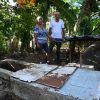Tuesday, April 30, 2024
News and Views from the Global South
SRI LANKA: Tsunami Recovery Skewed by Sectarian Strife
Amantha Perera
- Mohideen Ajeemal is determined to put the dark days of the Dec. 26, 2004 tsunami, which claimed two of his children, behind him.
‘'I am looking forward, not behind,'' he told IPS as he sat in the rebuilt premises of his fish wholesale business on the Kalmunai beach in eastern Sri Lanka. "I am happy, life is almost normal and things are moving on. Business is not perfect but it is catching up.''
More than 8,000 people perished along the stretch of beach that Ajeemal calls home and where the rampaging waves made landfall in Sri Lanka around 9.30 a.m. local time on that fateful Christmas.
Ajeemal has acquired a new home under the massive 3.5 billion US dollar rehabilitation programme. He considers himself lucky because two years after the catastrophe, which killed 38,000 Sri Lankans and made a million others homeless, it is fair to say the effort has been stymied by political interference, bureaucratic bottlenecks and ethnic strife.
Fewer than half of the required 110,000 houses have been constructed. But what is of concern is that the worst hit areas, the north and east of the island country, appear to have been grossly neglected at the cost of better rehabilitation and reconstruction in the Sinhala-dominated south, leading to charges of discrimination and political patronage.
In southern Hambantota district, the home base of President Mahinda Rajapakse, the housing programme boasts a completion rate of 173 percent. In contrast, eastern Ampara district, where the requirement is for 27,810 houses, the completion rate is a low 39 percent, according to the state-run Reconstruction and Development Agency (RADA).
Overprovision is a feature of all the southern districts, just as serious shortfalls are characteristic of northern and eastern districts which are dominated by ethnic Tamils and have been witness to spiralling violence between Tamil militants and the Sri Lankan armed forces over the past year. In Trincomalee, centre of pitched battles, there is a shortfall of 3,000 houses.
"What is particularly striking is the overprovision of house reconstruction in the south, which clearly indicates an inequitable allocation of resources from a national perspective," the United Nations said last month in a report titled ‘Approaches to Equity in Post Tsunami Assistance; Sri Lanka, a Case Study', published by the office of the U.N. Special Envoy for Tsunami Reconstruction.
The government has not officially commented on the disparity but has blamed the slow progress in the north and east on the violence and also charged international agencies with not living up to expectations.
Hostilities between government forces and Tamil militants fighting for a separate homeland claimed more than 3,500 lives last year, seriously violating a four-year-old ceasefire.
The violence has brought reconstruction efforts in the north and east to a standstill with some agencies having had to pull out staff due to safety fears. "It is not the lethargic attitude but delay in process due to unavoidable circumstances. In the conflict areas the work has been hampered to some extent. But despite the fact that security is not so good in some areas we have still managed to reconstruct," RADA head Shanti Fernando said.
For their part, international agencies and relief groups which have increasingly come under criticism from the government and its nationalistic allies have called for policy adjustments and changes in implementation. "Of particular concern were unconfirmed reports of financial mismanagement, of the contradictory number of the houses destroyed and of aid not reaching the worst affected in sufficient quantity. The discrepant pace of construction across districts has also blemished an otherwise decent record of post-tsunami reconstruction," the World Bank said in its two years assessment report.
The housing reconstruction was left stumped right at the onset when the government imposed a no-build buffer zone along the coast which was rescinded in December 2005 by the newly installed Rajapakse government. But the change created a new list of bottlenecks. "New beneficiary lists have to be established for both assistance programmes, funding has to be sourced/reallocated for the new addition of beneficiaries, identifying scope, time, as well as resources required for these tasks is a challenge," the government and its development partners said soon after the changes were made.
RADA head Fernando nevertheless predicted that the housing reconstruction effort would be complete by the end this year but others appear pessimistic. "At this rate of housing reconstruction it would take at least five years to complete the housing reconstruction programme," said local researcher Muttukrishna Sarvananthan, who carried out a countrywide survey on tsunami beneficiaries.
Other aftereffects of the waves run deeper. The Sarvananthan study found that poverty levels among tsunami victims had deteriorated after the tragedy.
"Poverty, in terms of both headcount and severity, had increased after the tsunami in comparison to before in all three regions under consideration," the study titled ‘People's Verdict on Tsunami Recovery in Sri Lanka,' said. ‘'The household income data from the survey reveal that the majority of the tsunami affected households live in absolute poverty."
Sarvananthan told IPS that poverty levels in the south, north and east had jumped from 64 percent to 80 percent after December 2004. The survey revealed that 57 percent of the tsunami-hit families earned less than one dollar a day, the internationally accepted poverty line. Befor the tsunami it was 34 percent.
All this makes Kalmunai's Ajeemal even more satisfied with the defiant stand he took soon after December 2004. He was among the first to return to the devastated beach and recommence business ignoring the buffer zone ruling. "I never wanted to depend on others, you never know what will happen,'' Ajeemal said.

 Print
Print



